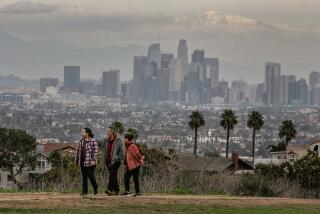The Long and Short of It
- Share via
We learned some good news about winter the other day. Already the shortest season, it’s getting shorter, and will continue to do so long after we care anything about it--until the year 3500, when it will be about six hours shorter than it is this year.
This information was gleaned while listening to John Mosley on the Griffth Observatory tape--you can tune in by dialing (213) 663-8171. We had merely wanted to know when winter would officially arrive. The solstice was Saturday at 2:08 p.m. But that was just the beginning of what he had to say. Winter this year will last 88 days, 23 hours, 54 minutes and 47 seconds--30 seconds shorter than last year, which is encouraging for all of us who can’t wait for spring.
Saturday, as the shortest day of the year, lasted 9 hours and 53 minutes in Los Angeles between sunrise and sunset. That contrasts with the 14 hours and 25 minutes that we will enjoy next June 21, when summer returns. The elongation of the day is not at a constant rate because of the irregularity of the Earth’s orbit. The Earth slows down and speeds up, depending on its proximity to the sun. Hold your hats on Jan. 4: We will be at maximum speed as we reach the orbit point closest to the sun, Mosley told us.
Solstices are really not the big thing these days at the observatory. Halley’s comet is the center of attention, with large but diminishing crowds gathering for early-evening views. Anyone with binoculars and a place away from city lights can now make out the comet, although it resembles nothing more exciting than a “small fuzzy star,” Mosley said. If you want to know where to look, listen to his tape. There will be a better view in January, and maybe again at the end of April, although nothing to compare with what people in the Southern Hemisphere will see.
More to Read
Sign up for The Wild
We’ll help you find the best places to hike, bike and run, as well as the perfect silent spots for meditation and yoga.
You may occasionally receive promotional content from the Los Angeles Times.






